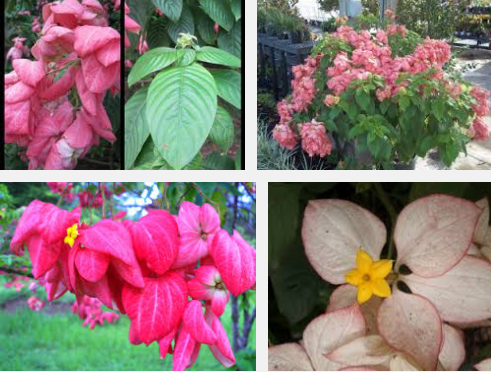
Characteristics of Mussaendas
Mussaendas’ spectacular beauty comes from its colorful bracts in large trusses- Dona Luz has large dark pink bracts, peach or pink bracts while Doña Aurora has white bracts with small yellow flowers in the center. Their leaves are pale-green and hairy. Both varieties are named after former first ladies.
Aside from being a showstopper, Mussaendas are versatile plants that are relatively easy to grow. Most Mussaendas need lots of sun and thrive well in sandy soil. They can grow up to three meters.
Mussaendas become dormant by shedding their leaves between December and April. At this time, they look dried up and dead. This happens when the temperature starts going down in the last week of December. Dormancy has also been linked to rainfall pattern and soil moisture.
Controlling the time of flowering by pruning
To induce Mussaendas to bloom even during the dormant period, the scientists single-pruned the seedlings leaving three healthy pruned stems per plant. The plants were fertilized once a week with urea and complete fertilizer alternately for a month. Dona Aurora and Dona Luz seedlings pruned in November flowered after 5 to 9 Weeks. Also, Mussaendas pruned in April and May took 4 to 5 weeks to flower while those pruned in June and July bloomed after 5 to 7 weeks.
After the experiment, the scientists developed a protocol for producing small-potted flowering Mussaenda using cuttings of flowering shoot tips as the propagation materials. Backyard growers/cooperators in Los Baños were trained on the production of small-potted Mussaendas using the protocol below.
Protocol for producing small-potted flowering Mussaenda
- Harvest shoots at stage 1 flowering
- Cut the basal end of the cuttings
- Apply hormone at the basal end of the cuttings
- Plant cuttings in pots with a mixture of 1 part sand, 1 part coir dust and 1 teaspoon Multicote
- Place the cuttings in a misting chamber for 4 weeks
- Transfer rooted cuttings from the misting chamber to a place with partial shade for hardening
- Condition cuttings under partial shade
The mass propagation trial using the protocol was successful. The first flowering shoots were harvested in the first week of November 2001 and sold to Ayala Property Management Corporation. A cost and return analysis showed that the venture could be profitable for grower-cooperators. This is good news for farmers and entrepreneurs who are interested in selling Mussaendas especially during the Christmas season when these show-stoppers could be used to substitute the poinsettias that adorn many a Filipino home and workplace.
————————————-
Source:
Year-round production of small potted flowering Mussaenda through off-season production of flowering shoot by Primitivo Jose Santos, Calixto Protacio and Reynold Pimentel of the Institute of Plant Breeding, College of Agriculture (IPB-CA) in the University of the Philippines at Los Baños (UPLB)
By: Junelyn S. de la Rosa, BAR Digest, October-December 2003 Issue (Vol. 5 No. 4)


What does mean “stage 1 flowering” ?? It means before, during, or after flowering??
Thanks